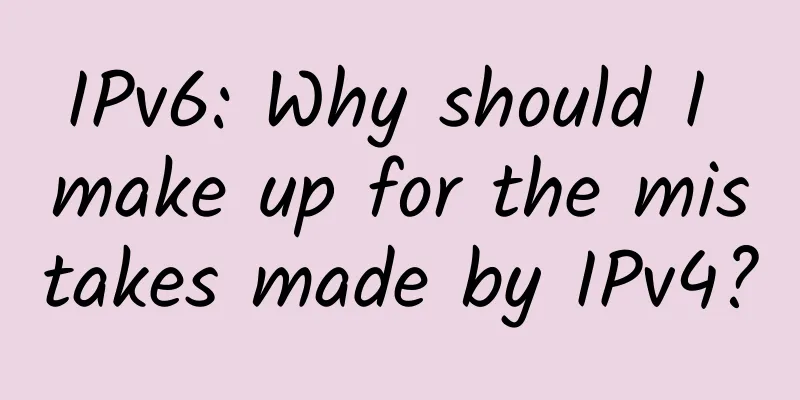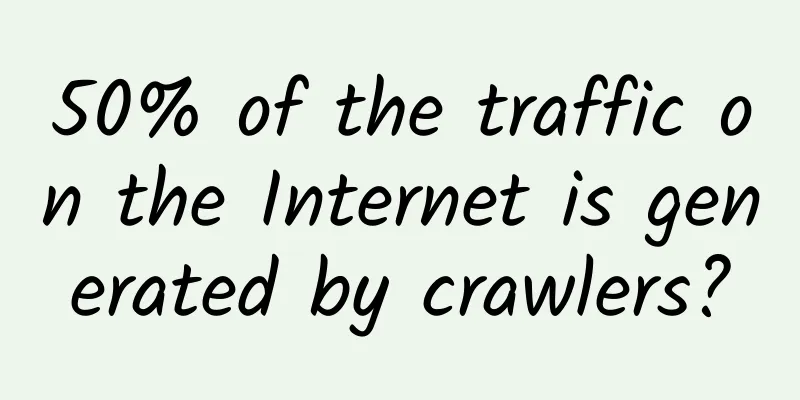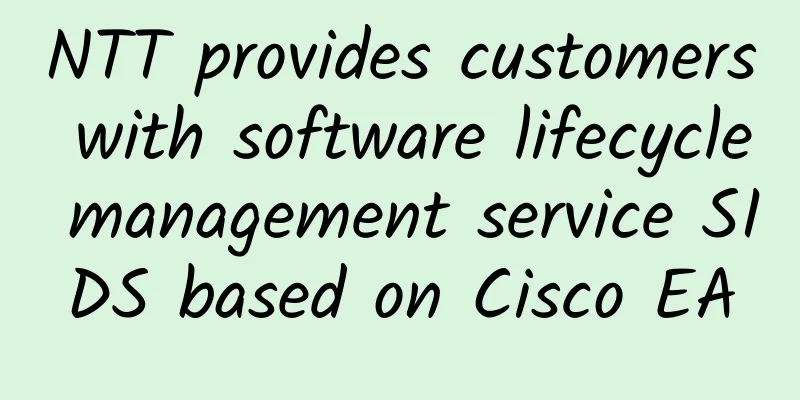IPv6: Why should I make up for the mistakes made by IPv4?

|
IPv6 should have been developed greatly in the past decade, but it did not happen. As a result, most people do not know some knowledge about IPv6: what is it, how to use it, and why does it exist? Differences between IPv4 and IPv6 What did IPv4 do wrong? We have been using IPv4 since RFC 791 was published in 1981. At that time, computers were large, expensive, and rare, and IPv4 claimed to provide 4 billion IP addresses, which seemed like a very large number at the time. Unfortunately, these many IP addresses are not fully utilized, and there are gaps between addresses. For example, a company may have 254 (28-2) addresses, but only use 25 of them, leaving the remaining 229 empty for future use. These idle addresses cannot be used to serve the users who really need them because of the limitations of network routing rules. The end result is that the number that seemed very large in 1981 seems very small in 2014. The Internet Engineering Task Force (IETF) pointed out this problem in the early 1990s and provided two solutions: Classless Inter-Domain Routing (CIDR) and private IP addresses. Before the emergence of CIDR, you could only choose three network address lengths: 24 bits (a total of 16,777,214 available addresses), 20 bits (a total of 1,048,574 available addresses), and 16 bits (a total of 65,534 available addresses). After the emergence of CIDR, you can divide a network into multiple subnets. For example, if you need 5 IP addresses, your ISP will provide you with a subnet with a 3-bit host address, which means you can get a maximum of 6 addresses (LCTT: Putting aside the network number of the subnet, the 3-bit host address length can represent 8 addresses from 0 to 7, but the 0th and 7th have special uses and cannot be used by users, so you can get a maximum of 6 addresses). This method allows ISPs to allocate IP addresses as efficiently as possible. The effect of the "private address" solution is that you can create a network yourself, and the hosts in it can access the hosts on the external network, but the hosts on the external network will find it difficult to access the hosts on the network you created, because your network is private and invisible to others. You can create a very large network because you can use 16,777,214 host addresses, and you can divide this network into smaller subnets for your own management. Maybe you are using private addresses now. Look at your own IP address. If it is in these ranges: 10.0.0.0 – 10.255.255.255, 172.16.0.0 – 172.31.255.255, or 192.168.0.0 – 192.168.255.255, then you are using private addresses. These two schemes effectively delayed the disaster of "IP address exhaustion" for a long time, but they were only temporary measures after all, and now we are facing the final judgment. Another problem with IPv4 is that the message header of this protocol is variable in length. If data routing is implemented by software, this problem is not a big deal. But now router functions are provided by hardware, and it is difficult for hardware to handle variable-length message headers. A large router needs to handle a large number of data packets from all over the world, and the load on the router is very large. So it is obvious that we need to fix the length of the message header. When allocating IP addresses, there is another problem. The Internet was invented by Americans (LCTT: This evil capitalist country occupies a large number of IP addresses). Other countries only get fragments of IP addresses. We need to customize an architecture so that continuous IP addresses can be concentrated in geographical locations, so that the routing table can be made smaller (LCTT: Think about it, the Internet speed will definitely be faster). There is another problem, which may sound hard to believe, that is, IPv4 is difficult to configure and difficult to change. You may not encounter this problem because your router does these things for you, so you don't have to worry about it. But your ISP has always been a headache about this. The next generation of the Internet needs to take all of the above issues into consideration. IPv6 and its advantages In December 1995, IETF announced the next generation IP address standard, named IPv6. Why not IPv5? →_→ Due to some mistake, the number "version 5" was used by other projects. The advantages of IPv6 are as follows:
Let’s analyze these features one by one: address When people talk about IPv6, the first thing they notice is that it has a lot of addresses. Why so many? Because the designers consider that the addresses cannot be fully utilized, we must provide enough addresses for users to squander in order to achieve some special purposes. So if you want to set up your own IPv6 network, your ISP can assign you a network with a 64-bit host address length (which can be assigned 1.844674407×101? hosts), and you can play with it as you like. polymerization With so many addresses, these addresses can be sparsely assigned to hosts, allowing for more efficient routing of packets. To do the math, your ISP gets an 80-bit address space, 16 of which are the ISP's subnet address, and the remaining 64 bits are allocated to you as the host address. This way, your ISP can assign 65,534 subnets. However, these address allocations are not set in stone. If an ISP wants to have more subnets, it can do so (of course, rich ISPs may require another 80-bit network space). The 48-bit addresses of the *** are independent of each other, which means that although ISPs may be allocated the same 80-bit network space, the two spaces are isolated from each other. The advantage is that the addresses in one network space will be aggregated together. Fixed message header length The IPv4 header is variable in length, but the IPv6 header is fixed at 40 bytes. The IPv4 header is longer due to additional parameters, but in IPv6, if there are additional parameters, these information will be placed next to the header and will not be processed by the router. When the message reaches the destination, these additional parameters will be extracted by the software. The IPv6 message header has a part called "flow", which is a 20-bit pseudo-random number used to simplify the router's routing process for data packets. If a data packet has a "flow", the router can use this value as an index to look up the routing table, without having to slowly traverse the entire routing table to query the routing path. This advantage makes IPv6 easier to route. Automatic Configuration In IPv6, when a host is turned on, it checks the local network to see if any other host has used its IP address. If the address is not in use, it then queries the local IPv6 router, and once found, it requests an IPv6 address from it. Then the host can connect to the Internet - it has its own IP address and its own default router. If the default router goes down, the host will then look for another router as a backup router. This function is very difficult to implement in the IPv4 protocol. Similarly, if the router wants to change its address, it can change it by itself. The host will automatically search for the router and automatically update the router address. The router will save the old and new addresses at the same time until all hosts update their router addresses to the new address. IPv6 autoconfiguration is not a complete solution. To effectively use the Internet, a host needs something else: a domain name server, a time synchronization server, or a file server. So dhcp6 came into being, providing the same service as dhcp, the only difference is that the dhcp6 machine can be started in a routable state, and a dhcp process can provide services for a large number of networks. The only big problem If IPv6 is really that much better than IPv4, why hasn't it been widely used yet (Google estimated in May 2014 that IPv6 had a market share of 4%)? One of the most basic reasons is the "chicken and egg" problem. Service providers want their servers to serve as many customers as possible, which means they have to deploy an IPv4 address. Of course, they can use both IPv4 and IPv6 addresses, but few customers will use IPv6, and you will need to make some minor changes to your software to accommodate IPv6. Another headache is that many home routers do not support IPv6 at all. In addition, ISPs are unwilling to support IPv6. I asked my ISP about this and the answer I got was: they will only use IPv6 if customers explicitly specify that they want to deploy this. Then I asked how many people have this demand now, and the answer was: including me, there are 1 in total. In stark contrast to this reality, all major operating systems: Windows, OS X, Linux have supported IPv6 by default for many years. These operating systems even provide software to cover IPv6 packets with IPv4 skin to deceive hosts that will discard IPv6 packets, thereby achieving the purpose of transmitting data. Summarize IPv4 has served us well for a long time. However, its shortcomings will become insurmountable in the near future. IPv6 can solve this problem by changing the address allocation rules, simplifying the packet routing process, and simplifying the configuration process when a VPN joins the network. The problem is that the public is slow to adopt and use IPv6 because the cost of change is too high. The good news is that all operating systems support IPv6, so if you want to make a change one day, your computer only needs to change a few things to switch to the new architecture. |
<<: How will network reconstruction proceed in the future?
>>: Several secrets to protect cabling in green data centers
Recommend
Small functions of wireless routers make your Wi-Fi more useful
Have you just bought a wireless router and you ju...
51CTO Community Thousands of Developers Interacted: Five Challenges Need to Be Unlocked Before AI Can Become a Reality
[51CTO.com original article] Which technology is ...
Huawei's Hou Jinlong: Grow together with global developers and win together in the new era of computing
On March 27, at the Huawei Developer Conference 2...
RAKsmart: San Jose servers start at $46/month, 1GB unlimited data servers start at $199/month
RAKsmart's discounts continue this month. In ...
GaN and SiC power semiconductor market expected to exceed $4.5 billion by 2027
The booming development and promotion of 5G techn...
How many gateways in Flowable do you know?
Gateway Gateways are used to control the flow of ...
Everyone is promoting 5G products and 5G phones. Is 5G really that good? Should I choose a 4G or 5G phone?
The word 5G is "very hot". The topic of...
Dedicated 5G networks for smart sports stadiums and venues
Advances in technology are dramatically changing ...
How to use 4G module to transmit temperature and humidity data to onenet via MQTT protocol
[[397604]] This experiment uses the SIM7600CE 4G ...
With this, you will never be able to steal my chicken again!
When I was a kid, there was always a big yellow d...
A thorough investigation of the history behind Huawei's high-quality Wi-Fi ONTs
[51CTO.com original article] Only after careful c...
Review of 5G standards in 2020: R16 standard freezes and improves capability triangle, opening a "new era" for commercial use
[[374016]] In order to better review the gratifyi...
At the Huawei Maimang 8 launch event, He Gang of Huawei said that the greater the challenge, the greater the achievement
At the launch of Huawei Maimang 8 mobile phone, t...
5G infrastructure scale leads the world, accelerating the implementation of 5G applications is the key to future development
After more than a year of commercial use, China h...
[Double Holiday] DesiVPS: $15/year-1GB/15G NVMe/1.5TB@10Gbps/San Jose Data Center
DesiVPS released a Christmas promotion plan, whic...









